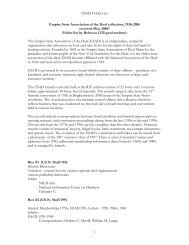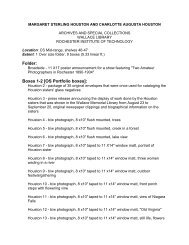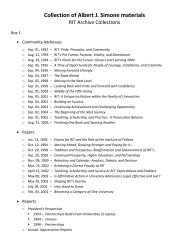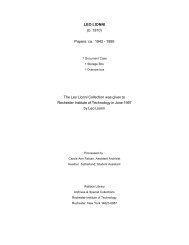The Work of Ismar David at the Cary - RIT Libraries - Rochester ...
The Work of Ismar David at the Cary - RIT Libraries - Rochester ...
The Work of Ismar David at the Cary - RIT Libraries - Rochester ...
Create successful ePaper yourself
Turn your PDF publications into a flip-book with our unique Google optimized e-Paper software.
<strong>The</strong> <strong>Work</strong> <strong>of</strong><br />
<strong>at</strong> <strong>the</strong> <strong>Cary</strong> Collection<br />
Biographical Sketch (cont’d)<br />
Hebrew alphabets. <strong>The</strong> two spent six years toge<strong>the</strong>r before<br />
Hortense died on October 9, 1960.<br />
Upon his arrival in New York City in 1953, <strong>Ismar</strong> <strong>David</strong> established<br />
a design studio and began teaching L<strong>at</strong>in calligraphy <strong>at</strong><br />
Cooper Union and Pr<strong>at</strong>t Institute. He had expected <strong>the</strong> bulk <strong>of</strong><br />
his commissions to come from designing decor<strong>at</strong>ive elements<br />
for synagogues, however, he found his mainstay work in <strong>the</strong><br />
1950’s, 60’s, and early 70’s in <strong>the</strong> publishing industry. <strong>David</strong><br />
worked steadily as a designer for leading American publishers<br />
including Alfred A. Knopf; Atlantic, Little Brown; Ballantine<br />
Books; Fleming H. Revell; Harper & Row; Harry Abrams;<br />
Houghton Mifflin Company; J.B. Lippincott Company; McGraw-<br />
Hill; Pocket Books; Random House; Thomas Y. Crowell; and<br />
Viking Press, among o<strong>the</strong>rs. In a short span, he designed book<br />
jackets or covers for more than 200 books.<br />
<strong>Ismar</strong> <strong>David</strong> remained a free-lance artist throughout his career.<br />
In addition to steady work in cover design, calligraphy, and<br />
lettering, <strong>Ismar</strong> <strong>David</strong> earned commissions for book illustr<strong>at</strong>ion<br />
and developed <strong>the</strong> style <strong>of</strong> illustr<strong>at</strong>ion for which he is best<br />
remembered—a style characterized by striking p<strong>at</strong>terns <strong>of</strong><br />
lines. This distinctive linear style was particularly well suited<br />
for <strong>the</strong> Limited Edition Club’s 1971 public<strong>at</strong>ion <strong>of</strong> Pascal’s Les<br />
Pensées, for which <strong>David</strong> cre<strong>at</strong>ed a dozen full-page, hypnotic<br />
color-illustr<strong>at</strong>ions—pre-separ<strong>at</strong>ed in <strong>the</strong> tradition <strong>of</strong> printmaking—as<br />
well as ornamental tailpieces, and text frames. As<br />
would become his custom, <strong>Ismar</strong>’s conceptions in vivid<br />
oranges, greens, purples, blues, and golds were meant to<br />
accompany <strong>the</strong> thoughts <strong>of</strong> <strong>the</strong> author, not to illustr<strong>at</strong>e <strong>the</strong>m<br />
page 7






![A Conversation with Danny Glover & Joslyn Barnes [PDF]](https://img.yumpu.com/17810254/1/190x245/a-conversation-with-danny-glover-joslyn-barnes-pdf.jpg?quality=85)









